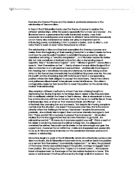Thomas Hardy's use of Imagery in Tess of the D'Urbervilles
Hardy uses imagery in Tess of D’Urbervilles for a number of things including; to foreshadow upcoming events, accentuate Tess’s purity, and to represent characters hidden personalities. It is to allow the reader to have a secondary understanding of the novel as it goes on.
Hardy uses imagery to foreshadow upcoming events which in turn creates a sense of dramatic irony to add a sense of foreboding and ominousness. In phase I, during Princes death, Hardy uses violent, sexual imagery in the line “The pointed shaft of the cart had entered the breast of the unhappy Prince” which can be analysed to foreshadow Tess’s rape. This is due to what could be described as sexual language; “Pointed Shaft” and “breast” but also the choice of wording in “Unhappy Prince” is important because it is an odd choice as the horse is dying. This is just like Tess’ rape as she is unhappy but doesn’t necessarily try to stop it occurring. Hardy foreshadows Angel Clare abandoning Tess for the second time following the Pagan Dance; “He had not observed her, and with that in mind, he left the pasture”. The fact that Hardy tells the reader that Angel realises he had missed her, but still “he left the pasture” leaving her alone gazing after him. This is also similar to when he abandons her once she admits she is not ‘pure’ and he leaves. Hardy also subtly foreshadows Tess’ hanging later on in the novel, at the Dairy pasture by describing the cutlery as “Like the beginning of a gallows” which calls upon a dark an ominous feeling than apparently easy, normal breakfast scene. This in turn is just like Tess she goes from a normal life to one that is dark and eventually is a running murderess; giving the reader the knowledge from early on that Tess has a bad fate in store.








